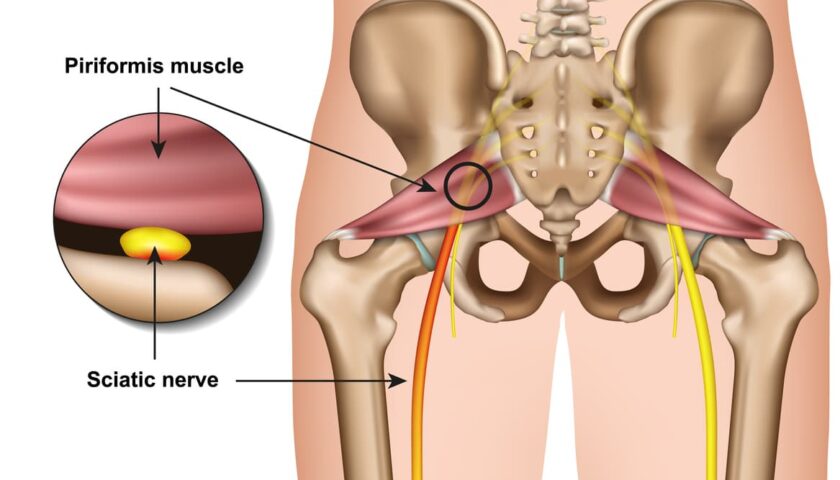Introduction: Piriformis syndrome, though not as commonly known as other musculoskeletal conditions, can be a source of significant discomfort and pain for those who experience it. This condition is often misdiagnosed as sciatica due to the similarity in symptoms, but understanding its distinct characteristics is essential for proper diagnosis and treatment. In this guest post, we will explore the symptoms of piriformis syndrome, its potential causes, and the available relief options.
Understanding Piriformis Syndrome:
The piriformis muscle is a small, pear-shaped muscle located deep within the buttocks, near the sciatic nerve. Piriformis syndrome occurs when this muscle becomes inflamed or tight, leading to the compression or irritation of the sciatic nerve, which runs from the lower back down the back of the leg. As a result, individuals with piriformis syndrome often experience symptoms that mimic those of sciatica.
Symptoms of Piriformis Syndrome:
- Pain in the Buttocks: One of the hallmark symptoms of piriformis syndrome is a deep, aching pain in the buttocks. This pain may be sharp, stabbing, or throbbing and is often felt on one side of the buttocks.
- Radiating Leg Pain: Piriformis syndrome can cause pain to radiate down the back of the leg. The discomfort can extend all the way to the calf or even the foot, making it difficult to distinguish from sciatica.
- Numbness and Tingling: Individuals with piriformis syndrome may experience numbness, tingling, or a pins-and-needles sensation in the buttocks, leg, or foot. This is a common symptom due to the compression of the sciatic nerve.
- Aggravation with Activity: Symptoms of piriformis syndrome are often aggravated by certain activities, such as walking, running, or sitting for extended periods. The pain tends to worsen when pressure is apply to the piriformis muscle.
- Pain when Sitting: Sitting for extended periods can be particularly uncomfortable for those with piriformis syndrome. The pain is often relieve when standing or walking.
- Muscle Tightness and Weakness: Patients may notice muscle tightness in the buttocks, as well as weakness in the affected leg. These symptoms can further hinder mobility and comfort.
Potential Causes of Piriformis Syndrome:
While the exact cause of piriformis syndrome can vary from person to person, several common factors are associate with the condition:
- Overuse or Strain: Overexertion of the piriformis muscle, often due to activities like running or excessive sitting, can lead to inflammation and subsequent compression of the sciatic nerve.
- Anatomical Variations: Some individuals have anatomical differences that predispose them to piriformis syndrome, such as the sciatic nerve passing through or beneath the piriformis muscle.
- Trauma or Injury: A fall or direct injury to the buttocks can trigger the onset of piriformis syndrome.
- Muscle Spasms: Spasms of the piriformis muscle can also lead to compression of the sciatic nerve.
Seeking Relief from Piriformis Syndrome:
If you suspect you have piriformis syndrome based on your symptoms, it is essential to seek medical evaluation and diagnosis. A healthcare professional, such as a physical therapist or orthopedic specialist, can help determine the underlying cause and provide appropriate treatment. Here are some common relief options:
- Physical Therapy: Physical therapists can teach exercises to stretch and strengthen. The piriformis muscle, helping to alleviate symptoms and prevent future flare-ups.
- Medication: Nonsteroidal anti-inflammatory drugs (NSAIDs) may be prescribe to reduce pain and inflammation.
- Heat and Ice Therapy: Applying heat or ice to the affected area can help reduce discomfort and promote healing.
- Injections: In some cases, corticosteroid injections can provide short-term relief by reducing inflammation around the piriformis muscle.
- Lifestyle Modifications: Making adjustments to your daily activities. Such as avoiding prolonged sitting and engaging in regular stretching exercises, can help manage and prevent symptoms.
Conclusion:
Piriformis syndrome, though often mistake for sciatica, is a distinct condition with its own set of symptoms and causes. Recognizing these symptoms and seeking timely diagnosis and treatment is essential for those affected by this often-painful condition. With the guidance of healthcare professionals, lifestyle modifications, and appropriate therapies. Relief from piriformis syndrome is possible, and individuals can regain. Their quality of life free from the discomfort and pain it brings.

